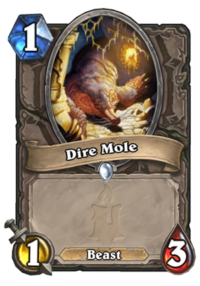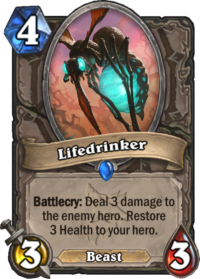We all remember the flashy, meta-breaking cards or the ones that flew under the radar but nonetheless ended up creating new archetypes from scratch. Less attention is given to those unassuming little critters that may lack the fancy stat-lines or unique card texts we’re looking out for in the card reveal season but do an excellent job slotting into a wide variety of different decks, being able to fill some interesting utility roles. If you can spot these from the upcoming expansion, chances are you’ll gain a bit of an edge on the field in the early days of Rastakhan’s Rumble.
The Little Beasts That Could

Perhaps the best example of unassuming little minions that would go on to form the backbone of certain strategies is Dire Mole, a 1/3 little beast for a single mana. Murloc Paladin has already showed the importance of this statline in the early game with Vilefin Inquisitor, and Voidwalker was a key component of Zoo since the dawn of time, but this was finally a neutral option which turned out to be fairly valuable even in non-Hunter decks where the Beast synergy didn’t apply. The fact that it’s difficult to remove in an aggro mirror early on makes it invaluable for the classes that can leverage that extra ping well: Odd Rogue’s hero power and Odd Paladin’s capacity to generate endless 1/1 Recruits both apply, and while it certainly wasn’t going to supersede the pre-nerf Mana Wyrm in Mage, it was a very valuable inclusion in every aggro deck that didn’t have a superior class card to fill a similar niche. Today, Crystallizer occasionally replaces it in non-Hunter decks, simply because of a very minor benefit against Alexstrasza: however, it’s still the same coveted statline, meaning the underlying reasons behind its inclusion are the same.
On the other end of the spectrum, Plated Beetle is a great example of a card whose text didn’t seem good enough at first to push it into competitive viability. As it turns out, stacking armor has basically become strictly superior to health recovery, and the relatively low power level in the two-mana slot in the current Standard rotation meant that some decks found a use of either its effect of just the keyword, ranging from Even Warlock to Quest Priest and Deathrattle Rogue, with a special mention going out to the current Midrange Hunter builds that harken back to Lifecoach’s old iteration on the formula: instead of River Crocolisk, it might as well use the strictly better card to have more early-game options with enough health to survive until the crucial fourth turn.
There’s also Corpsetaker package and an acceptable anti-aggro solution, plus one of the main reasons behind Deathstalker Rexxar’s power spike once its beast pool got expanded by the later sets. The resurgence of Quest Rogue can also be at least partially attributed to this little minion.
Speaking of which, an honorable mention must go out to Glacial Shard, even if the card predates the current Standard year: applying Freeze to an individual minion was a fairly rare ability throughout Hearthstone’s history, and its tempo utility was not that appreciated by those who haven’t played a lot with subpar cards in the Arena where even Frost Elemental was often a viable choice. Utility effects like these can always find a home if the mana cost is not too prohibitive – something worth keeping in mind for the future.
Swiss Army Knives Galore

Sometimes it’s not for the lack of a unique ability that a card gets overlooked by the community – in certain cases, the value of the card text is not recognized or happens to be dependent upon later releases. Lifedrinker is perhaps the perfect example of this phenomenon: while no one could have predicted a card like Shudderwock to come around, this minion actually managed to play a part in two different aggressive decks. On the surface, it seems like a mediocre Nightblade wannabe with a negligible heal component, but the latter is exactly the sort of tool the newly discovered Heal Zoo archetypes needed. Not only that, but the card slotted in fairly well into Aggro Mage’s 4-mana slot simply as an additional burn option, meaning it saw a surprisingly large amount of play even outside of the infamous Shaman deck.
Mossy Horror is also an interesting specimen to consider: the obvious comparison came with Stampeding Kodo, a card that was very occasionally featured as part of certain Control Paladin builds thanks to its synergy with Aldor Peacekeeper and the class’ general lack of hard removal at the time. Otherwise, it was very much on the fringes of playability, which is why a more expensive version seemed unlikely to make any waves. What wasn’t foreseen was the complete collapse of the midrange archetypes and the card’s subsequent viability against aggro – and, of course, the omnipresence of Spreading Plague (and therefore Druid), not to mention Giggling Inventor’s rise and fall. In general, blanket effects like this one (“destroy all…”) should always be at the back of your mind as a potential tech tool under the right circumstances.
All in all, if you’d like to get a leg up on the field in the early days of the Rumble meta, try to keep an eye out for cards similar to the ones listed above: unassuming little buggers that quietly fill important archetypal roles. With the reveal season almost upon us, it’s a nice edge to have over the competition.

[…] of all, the statline itself makes the card great to begin with – just ask Dire Mole. It is especially so in the case of a class like Priest, which really needs a way to contest an […]
[…] neutral cards were also crucial in shaping the KnC metagame: Dire Mole and Plated Beetle were unsung early-game heroes while Zola the Gorgon and Carnivorous Cube broke the boundaries of realistic value options. Arcane […]